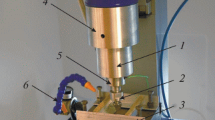Abstract
The structure and phase composition of Ni-Cr-Al alloys doped with Si, Ti, Mn, and Co have been studied. An eutectic three-phase structure was found to be in the doped alloys. Doping with Si and Ti increases the microhardness and wear resistance of the alloys. The highest coefficient of the mass transfer (0.75) during the electrospark alloying is observed for Co-containig alloys. The coatings with the doped alloys have a higher wear resistance than those with the Ni-Cr-Al basic alloy. Steel 45’s heat resistance is increased after the electrospark doping with Si-, Ti-, Mn-, and Co-containing alloys by 4, 4.3, 5.1, and 4.6 times, respectively. The electrode materials have been developed for the electrospark reconditioning of workpieces based on PE8418 (Ni-Ni3B-Cu-Si) with the additions of titanium carbide, chromium carbide, and tungsten carbide, which make it possible to manufacture coatings up to 5-mm thick. The results of the investigation of the erosion properties of B4C-TiB2 alloys manufactured using the method of reactive sintering under hot pressing of B4C-TiO2 powder blends that were used as the electrode materials for the electrospark hardening of titanium surfaces are presented. The tests show that, in the surface layers of the electrode materials, under the impact of the electric discharge, the boron carbide content substantially decreased, while the quantity of titanium borides increased and new phases of TiC x N y , TiO2, and Ti appeared. Only these components are transferred onto the surface of the titanium alloy and form there a protective coating up to 100 μm thick with high hardness (32–43 GPa) and wear resistance. The materials developed are promising for their application as the electrodes in the electrospark alloying of construction steels and titanium alloys.
Similar content being viewed by others
References
Paustovskii, A.V., Tkachenko, Yu.G., Alfintseva, R.A., Kirilenko, S.N., and Yurchenko, D.Z., Development of Electrode Materials for Electrospark Hardening and Reconditioning of Worn-Out Surfaces: The Structure and Properties of the Coatings, Surf. Eng. Appl. Electrochem., 2011, vol. 47, no. 2, pp. 126–131.
Sims, Ch.T., Stoloffa, N.S., and Khagel, Ts. K., Zharoprochnye materialy dlya aerokosmicheskikh i promyshlennykh energoustanovok (Heat Resistant Materials for Aerospace and Industrial Power Facilities), Moscow: Metallurgiya, 1995.
Grünling, H.W., and Bauer, R., The role of Silicon in Corrosion-Resistant High Temperature Coatings, Thin Solid Films, 1982, vol. 95, nos. 1–3, pp. 3–20.
Kolomytsev, P.G., Zharostoikie diffuzionnye pokrytiya (Heat Resistant Diffusion Coatings), Moscow: Metallurgiya, 1979.
Elliot and Hampton, A.F., The Influence of Ternary Additions of W, Mo, Ti, Ta, and Nb on the Isothermal and Cyclic Oxidation of Ni-10Cr Alloy, Oxid. Met., 1980, vol. 14, no. 5, pp. 449–468.
Irving, G.N., Stringer, J., and Whittle, D.P., Effect of the Possible ffc Stabilizers Mn, Fe, and Ni on the High Temperature Oxidation of Co-Cr Alloys, Oxid. Met., 1974, vol. 8, no. 6, pp. 393–407.
Kositsyn, S.V., Litvinov, V.S., Kataeva, N.V., and Arkhangel’skaya, A.A., Structural and Phase Stability of Heat Resistant (β + γ) Alloys of the System Ni-Co-Cr-Al, Fiz. Met. Metalloved., 1990, no. 9, pp. 114–122.
Tkachenko, Yu.G., Koval’chenko, M.S., Britun, V.F., Bovkun, G.A., and Yurchenko, D.Z., Manufacturing, Properties and Erosion Characteristics of Composite Materials B4C-Al, Poroshk. Metall., 2009, nos. 1/2, pp. 78–85.
Podchernyaeva, I.A., Panasyuk, A.D., and Lavrenko, V.A., et al., Structure and Properties of Composite Electrospark, Laser and Magnetron Coatings from AlN-TiB2 Material, Poroshk. Metall., 2001, nos. 9/ 10, pp. 69–77.
Teplenko, M.A., Podchernyaeva, I.A., Panasyuk, A.D., et al., Structure ans Wear resistance of the Coatings on Titanium Alloy from AlN-ZrB2 Material, Poroshk. Metall., 2002, nos. 3/4, pp. 48–57.
Polotai, V.V., Machines for Friction and Wear Testing, Teknol. Org. Proizv., 1970, no. 6, pp. 86–88.
Kolesnichenko, L.F., Polotai, V.V., and Zabolotnyi, V.V., Methods of Studying Friction and Wear of Metalloceramic Materials, Poroshk. Metall., 1970, no. 3pp. 61–66.
Khrushchov, M.M., O standartizatsii odnogo is metodov ispytaniya na abrazivnoe iznashivanie. Metody ispytaniya na iznashivanie (On Standardization of One Method of testing for Abrasive Wear. Test Methods for Wear), Moscow: Izd. AN SSSR, 1962.
Author information
Authors and Affiliations
Corresponding author
Additional information
Original Russian Text © A.V. Paustovskii, Yu.G. Tkachenko, R.A. Alfintseva, S.N. Kirilenko, D.Z. Yurchenko, 2013, published in Elektronnaya Obrabotka Materialov, 2013, No. 1, pp. 4–13.
About this article
Cite this article
Paustovskii, A.V., Tkachenko, Y.G., Alfintseva, R.A. et al. Optimization of the composition, structure, and properties of electrode materials and electrospark coatings for strengthening and reconditioningof metal surfaces. Surf. Engin. Appl.Electrochem. 49, 4–12 (2013). https://doi.org/10.3103/S1068375513010109
Received:
Published:
Issue Date:
DOI: https://doi.org/10.3103/S1068375513010109




